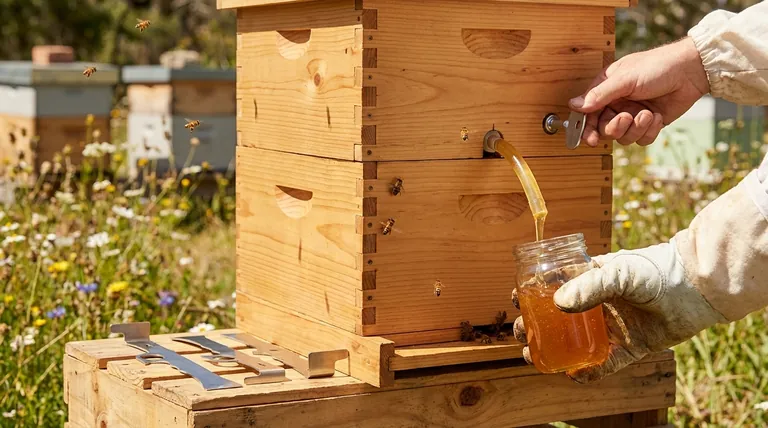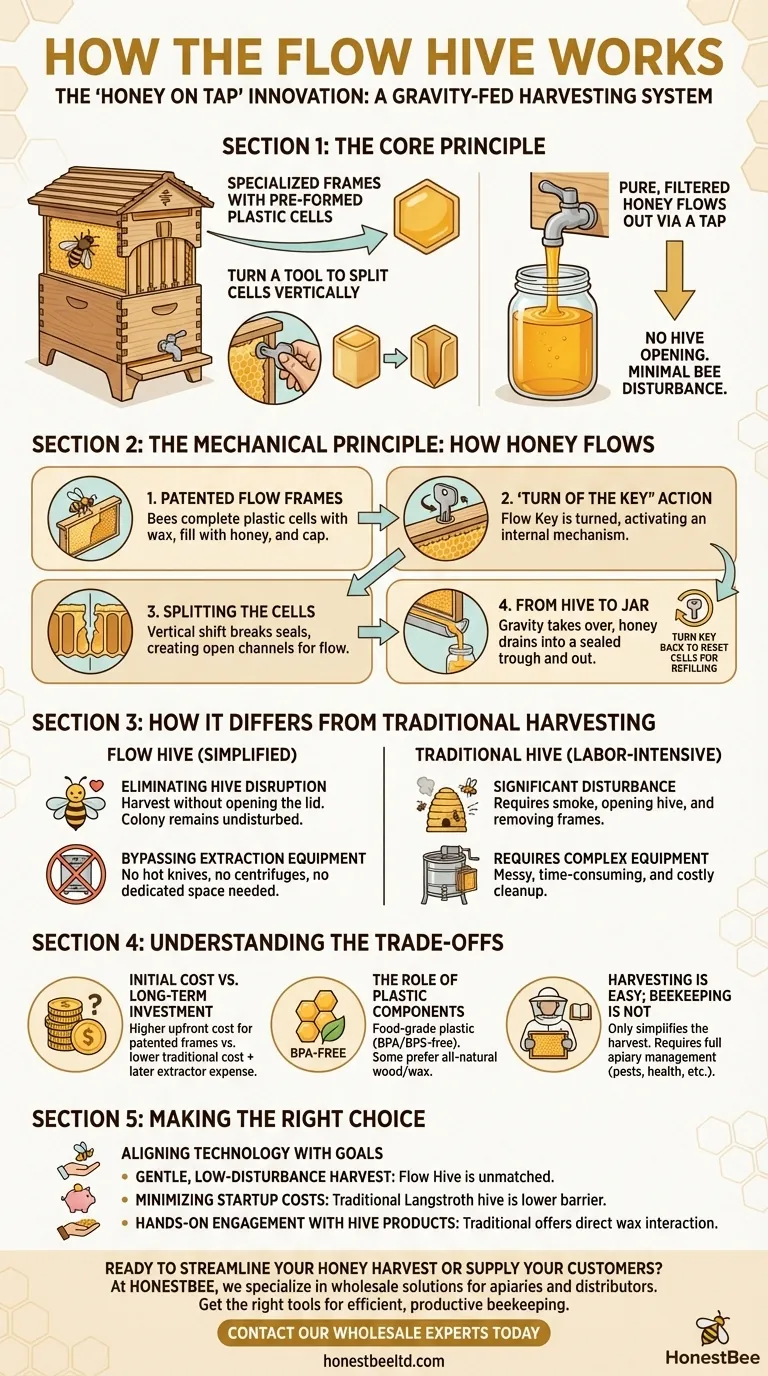At its core, the Flow Hive is a honey extraction system. It uses specialized frames with pre-formed plastic honeycomb cells that, with the turn of a tool, split vertically. This action breaks the wax seals and creates channels, allowing pure, filtered honey to flow directly out of the hive and into a jar via a tap, all without opening the hive or significantly disturbing the bees.
The central innovation of the Flow Hive is not in how bees are kept, but in how honey is harvested. It replaces the traditional, labor-intensive process of manual frame removal and centrifugal extraction with an integrated, gravity-fed mechanism built directly into the hive itself.

The Mechanical Principle: How Honey Flows
A Flow Hive looks similar to a standard Langstroth hive but contains a critical piece of technology in its upper box, or "super." Understanding this mechanism is key to understanding the entire system.
The Patented Flow Frames
The system's core is the Flow Frame. Unlike traditional frames where bees build their entire wax comb from scratch, these frames contain a partially formed honeycomb matrix made from BPA and BPS-free plastic.
The bees perceive these plastic cells as a foundation. They complete the cells with their own beeswax, fill them with honey, and then cap the cells with a final wax layer, just as they would in any other hive.
The "Turn of the Key" Action
Once the bees have filled and capped the honey cells, the beekeeper can harvest. This is where the unique mechanism comes into play.
A tool, the Flow Key, is inserted into an opening at the top of the frame. When this key is turned, it activates an internal mechanism that shifts the plastic cells vertically.
Splitting the Cells to Create Channels
This slight vertical shift is the critical action. It offsets the two halves of each honeycomb cell, breaking the wax cappings down the middle.
This movement transforms the sealed cells into a series of connected, open channels. Gravity then takes over, and the honey begins to flow downward through this newly formed network.
From the Hive to the Jar
The honey drains into a sealed trough at the bottom of the frame, which connects to an outlet tube. The beekeeper simply attaches a collection jar to the spout, and clean, filtered honey flows out.
After harvesting, the Flow Key is turned back to its original position. This resets the cells, which the bees then repair and can begin to refill with honey.
How This Differs from Traditional Harvesting
The Flow Hive's design was created to solve the primary challenges and labor-intensive steps of traditional honey extraction.
Eliminating Hive Disruption
In a conventional harvest, the beekeeper must open the hive, use smoke to calm the bees, and physically remove each heavy frame. The bees must then be brushed or blown off the frames, a process that can be stressful and agitating for the colony.
The Flow Hive allows for harvesting without even opening the lid, leaving the bee colony almost entirely undisturbed.
Bypassing Extraction Equipment
Traditionally, the wax cappings on honey frames must be cut off with a hot knife. The frames are then placed in a centrifugal extractor—a large, expensive machine—that spins at high speed to force the honey out.
This process is messy, requires significant cleanup, and necessitates a dedicated space. The Flow system bypasses all of this equipment.
Understanding the Trade-offs
While the harvesting method is simplified, it's crucial to recognize that the Flow Hive is not a "set-it-and-forget-it" solution. It is a tool with its own set of considerations.
Initial Cost vs. Long-Term Investment
The primary drawback of a Flow Hive is its significant upfront cost compared to a standard hive. You are paying for the patented mechanical frames. A traditional setup may be cheaper initially but will require later investment in extraction equipment.
The Role of Plastic Components
The honey is stored directly in contact with food-grade plastic. While the material is certified BPA and BPS-free, some beekeepers have a philosophical preference for keeping their hives entirely free of plastic, preferring natural wood and beeswax.
Harvesting Is Easy; Beekeeping Is Not
Perhaps the most common misconception is that the Flow Hive makes beekeeping easy. It only simplifies the final step of honey harvesting.
All other aspects of apiculture—including regular hive inspections, managing pests like Varroa mites, preventing swarms, and ensuring the colony is healthy and well-fed—remain unchanged and require the same knowledge and diligence as traditional beekeeping.
Making the Right Choice for Your Goal
Ultimately, the Flow Hive is a specialized tool. Choosing it depends entirely on your personal priorities as a beekeeper.
- If your primary focus is a gentle, low-disturbance harvest: The Flow Hive's "honey on tap" system is unmatched in its ability to extract honey with minimal stress on the bees.
- If your primary focus is minimizing startup costs: A traditional Langstroth hive offers a much lower financial barrier to entry, with harvesting equipment being a separate, later expense.
- If your primary focus is hands-on engagement with hive products: Traditional beekeeping provides direct interaction with beeswax and honeycomb, which can be harvested as standalone products.
Choosing the right hive is about aligning the technology with your specific beekeeping philosophy and goals.
Summary Table:
| Feature | Flow Hive | Traditional Hive |
|---|---|---|
| Harvest Method | Turn a key; honey flows out via tap | Remove frames; use extractor/spin |
| Bee Disturbance | Minimal (hive not opened) | Significant (frames removed) |
| Required Equipment | Built-in frames and tap | Extractor, uncapping knife, etc. |
| Initial Cost | Higher (patented technology) | Lower (basic hive components) |
Ready to streamline your honey harvest or supply your customers with the latest in beekeeping innovation?
At HONESTBEE, we specialize in supplying commercial apiaries and beekeeping equipment distributors with high-quality, wholesale-focused solutions. Whether you're looking to integrate the revolutionary Flow Hive system or source reliable traditional equipment, our expertise ensures you get the right tools for efficient, productive beekeeping.
Contact our wholesale experts today to discuss how we can support your operation's growth and efficiency.
Visual Guide

Related Products
- HONESTBEE Advanced Ergonomic Stainless Steel Hive Tool for Beekeeping
- Professional Dual-End Stainless Steel Hive Tool for Beekeeping
- HONESTBEE 72 Frame Industrial Electric Honey Extractor for Beekeeping
- Professional 3-Bar Frame Grip with Integrated Hive Tool
- Beehive Handle and Frame Rest Cutting Machine: Your Specialized Hive Machine
People Also Ask
- How is a hive tool used for scraping and cleaning? Master Hive Maintenance for a Healthy Colony
- How should beekeepers handle bees when using a hive tool? Master Calm, Deliberate Techniques
- What tools are used for cleaning frames? A Beekeeper's Simple 4-Tool Guide
- Why do hive tools have a hole? Unlock the Secret to Efficient Beekeeping
- What is a hive tool and what are its uses? Master Your Hive Inspections with the Essential Beekeeper's Tool



















